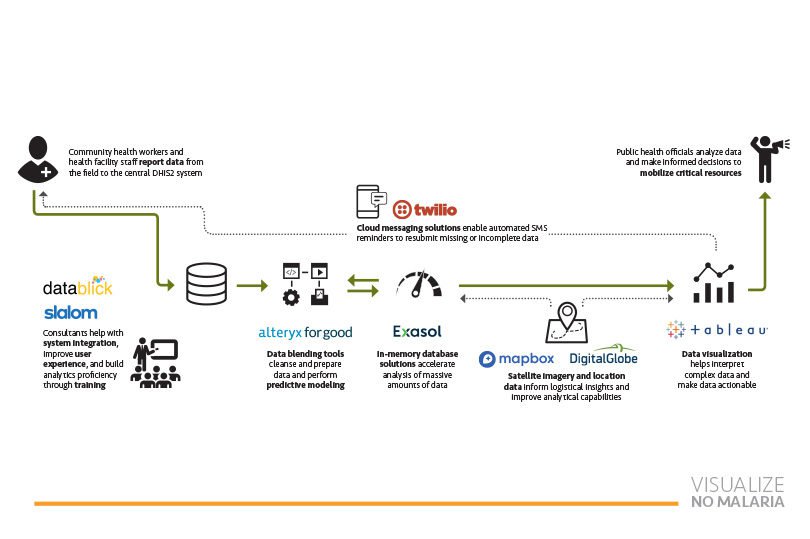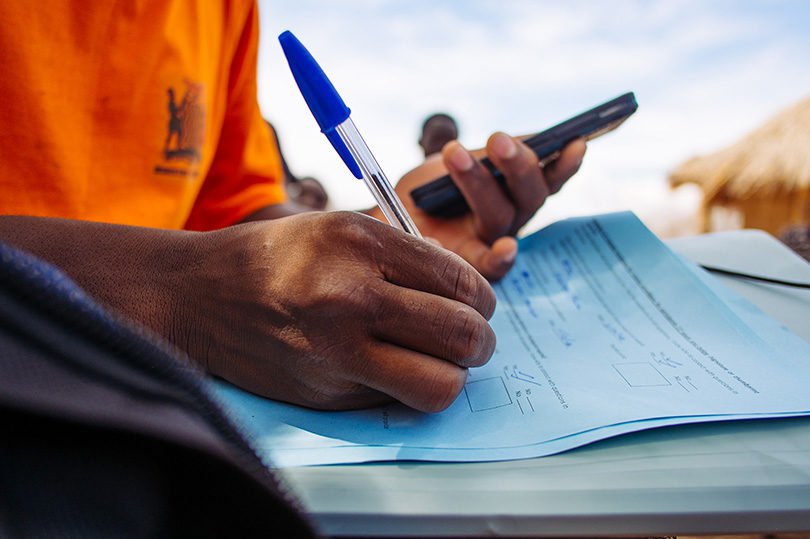The Zambian Ministry of Health, PATH, and the eight tech companies in the Visualize No Malaria initiative are proud to announce a joint commitment to support the government of Zambia’s goal to eliminate malaria within its borders. Our vision: through improved data analytics, best-in-class tools, and training, we can transform health intelligence and save lives. Our powerful multisector partnership has created an innovative approach that harnesses existing data sources and trains health workers to track, treat, and report on disease. This dynamic model can be scaled for impact across regions, countries, and health priorities, so health workers at all levels can count on fast, reliable data to make real-time decisions that outwit disease.
Using data for decision making
Over the past decade, the global health community has developed improved disease surveillance systems along with improved data collection and storage tools, yet key decisions still do not take full advantage of the data we collect. It still is too difficult for users, especially those who do not touch data every day, to easily generate insights or provide feedback to health workers on the ground who are trying to eliminate and control the disease. Visualize No Malaria—an innovative initiative that brings together the private sector, Zambia’s government, and PATH’s global health expertise—was formed in 2015 to address those gaps and to create better data management, analysis, reporting, and feedback loops. The best-in-class suite of tools integrates easily with a country’s existing data systems and adds analytic muscle to enrich the national surveillance system.
One aim of the initiative is to make users feel competent and successful when it comes to analyzing and using data to improve response to malaria. With Visualize No Malaria, national and provincial public health officials and health workers in Zambia’s Southern Province have more flexibility to link data from multiple sources, analyze it, and generate insights with user-friendly dashboards that show emerging disease patterns. These dashboards enable decision-makers at all levels of the health system to make data-informed decisions about where to deploy lifesaving resources, ensuring bednets reach the right places at the right times and expensive medications don’t expire on the shelf.
Multiplying impact
PATH has a 40-year legacy of creating dynamic and successful multisector partnerships. We’ve seen how convening government and private-sector partners can bring valuable skills and resources to global health challenges. When we work together, our impact multiplies.
Over the past three years, the Visualize No Malaria partners have contributed thousands of hours to help PATH transform lives potentially lost into human potential:
- The government of Zambia leads the commitment to malaria control and elimination and has been proactive in collecting data and ensuring its health system and personnel are prepared and dedicated to the goal of malaria elimination.
- Tableau provides a power visualization engine that allows end users to create user-friendly dashboards to analyze the malaria situation in real time. Expert users from DataBlick and Slalom traveled to Zambia and worked closely with district health workers and the Ministry of Health to iterate the dashboards.
- Mapbox and DigitalGlobe provide mapping resources, recruiting volunteers around the world to crowdsource data about human settlements and structures that can be overlaid with existing data on infrastructure, waterways, and weather. These data can be combined to create algorithms predicting where malaria cases emerge. Predictive models like these will enable community health workers to track and treat incidents faster, meaning new cases can be prevented and lives can be saved.
- Alteryx provides tools that automate workflows to quickly and efficiently process thousands of laboratory results, notify health workers, and track interventions.
- Twilio provides a cloud communication platform that allows users to exchange valuable insights and enables automated collection of missing and incomplete data from community health workers via text message.
- Exasol’s in-memory analytics database compresses massive amounts of data and serves them up fast in low-resource, lower-bandwidth settings.

Frontline health workers collect data that is fed into the national health system and turned into easy-to-use data visualizations that allow public health officials to view data in real time and make informed decisions about where to deploy resources.
Building capacity
The key to eliminating malaria lies not just in the tools, but in how they’re employed. The Visualize No Malaria initiative aims to cultivate a sustainable community of end users who are empowered to collect, combine, and analyze their data and to generate meaningful insights from it. We use in-person and virtual trainings—such as webinars—and we develop, pilot, and adapt tools so under-resourced professionals can accomplish a difficult job more easily.
In partnership with the Ministry of Health, we’ve helped build and train a cadre of community health workers to not only test for and treat malaria, but also to report case data into the national disease surveillance systems. There are now 3,200 trained community health workers across Southern, Western, Lusaka, and Central Provinces, covering more than one-third of the country.
As malaria declines across the country, the ability to quickly respond to cases as they arise is critical to progress. The goal is to equip community health workers with data that allow them to make informed decisions about where to deploy focalized spraying or drugs based on patterns they’re seeing without having to wait for the national program to provide resources and interventions.

Fortune Bwenje, malaria focal point person for Mazabuka, Zambia, answered questions from community health workers about data collection and reporting. Photo: PATH/Sarah Pickersgill.
“The data are like money; it should be managed well. If we make errors in our data, it means our decisions and plans will also have errors.”— Fortune Bwenje, malaria focal point person for Mazabuka, Zambia
Crossing borders
Access to better data has helped drive a 92 percent reduction in malaria-related deaths in Southern Province, Zambia, between 2014 and 2017. But malaria has no regard for borders. Collaboration between provinces and countries is key to making progress against this deadly disease.
We are excited about an opportunity to expand this model outward to the seven countries neighboring Zambia—Angola, Botswana, Mozambique, Namibia, South Africa, Swaziland, and Zimbabwe. High population movement and malaria transmission dynamics mean that the ability to achieve elimination in any one country is highly dependent on harmonized strategies that are mutually reinforced across the region. We also have the potential to apply the powerful Visualize No Malaria model to other diseases.
A model partnership
Engaging diverse experts who share our core values makes us smarter, brighter, and more responsive. The Visualize No Malaria initiative serves as a model for similar private-sector, government, and social-sector collaboration. It is a win-win for each of the partners.
For the public sector, the initiative enables data-driven decisions and the ability to track data quality and health worker performance.
For the private sector, engagement with Visualize No Malaria offers a unique space to innovate, collaborate, and explore new uses of data with fellow industry leaders. Companies can test new ideas together and bring improvements and insights back to their core products. And, of course, there’s the incomparable satisfaction of contributing to the fight against malaria.
“While the massive drops in rates of malaria infection and deaths are the most important thing to come out of this collaboration, the partnership has unearthed all types of opportunity and value,” said Neal Myrick, global head of Tableau Foundation. “It’s taught us how different people learn Tableau, and we’ve partnered with PATH to develop specialized training resources for the global health community. It has provided a sort of ‘stress test’ of our technical capabilities in a new setting and helped us strengthen some of our most important technical partnerships. Ultimately, it reinforces our belief that anyone can be a data person, regardless of where in the world they are or what their socioeconomic status is. It demonstrates the very real impact of delivering the right analysis to the right people at the right time. It is heartening.”

Visualize No Malaria “reinforces our belief that anyone can be a data person, regardless of where in the world they are or what their socioeconomic status is," says Neal Myrick, global head of Tableau Foundation. Photo: PATH/Gabe Bienczycki.
Finally, through this initiative, PATH reaffirms our position that when faced with the most vexing health challenges, traditional disease surveillance is not enough. We must embrace tools that help us move beyond passive measurement to actively applying health intelligence at all decision-making levels. Our collective efforts with Visualize No Malaria continue to push our learning and optimize data use. Most importantly, the Visualize No Malaria initiative catalyzes the transfer of state-of-the-art analytical skills to our counterparts in-country—the health workers and health officials who will ultimately defeat deadly diseases.
With unprecedented support from private, public, and social sectors, and a model designed for scale and sustainability, now is the time to invest and grow this groundbreaking work.
In the coming year, PATH hopes to leverage these best-in-class tools so country partners are able to turbocharge their legacy data tools and disease management systems. Together, the Visualize No Malaria initiative can enable enhanced analyses and intelligent health systems that provide decision-makers in Zambia and beyond with insights they can act on to prevent malaria and other diseases.
What is Visualize No Malaria?
Mission
Visualize No Malaria is a cross-sector initiative focused on integrating new tools and systems for data use to support Zambia’s Ministry of Health in their national efforts to eliminate malaria.
Vision
Our vision is that through improved data analytics, tools, and capacity, we can transform health intelligence and save lives. Together, our tools, expertise, and resources can significantly help Zambia in its efforts to eliminate malaria and become a scalable model for harnessing data for impact across regions and pressing health priorities.
Commitment
- The Visualize No Malaria initiative is committed to working together and collaborating with the malaria elimination community on utilizing the digital innovations from the Visualize No Malaria project in support of the Elimination 8’s goals.
- The Visualize No Malaria initiative is committed to supporting capacity-building and strengthening existing data management and visual analytics skillsets among nongovernmental organizations (NGOs) and country partners working on the goal of elimination.
- The Visualize No Malaria initiative is committed to supporting a cross-border data-sharing effort along Zambia’s borders with other Elimination 8 countries in order to show the value of data sharing for fighting diseases that do not respect borders.
- The Visualize No Malaria initiative believes this multisector collaboration is unique in the shared value it provides. The partners are committed to helping advance this type of private-sector, government, and NGO partnership as a mechanism for advancing malaria elimination and the Sustainable Development Goals.


